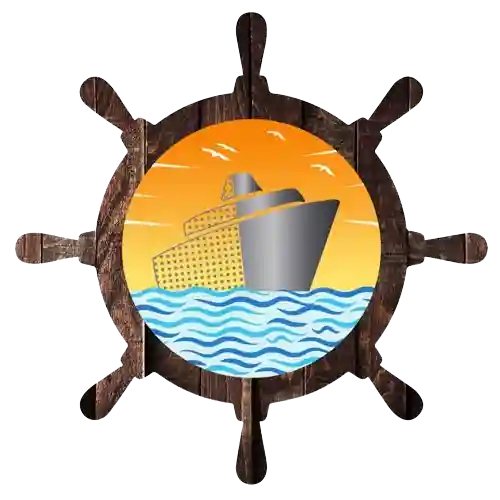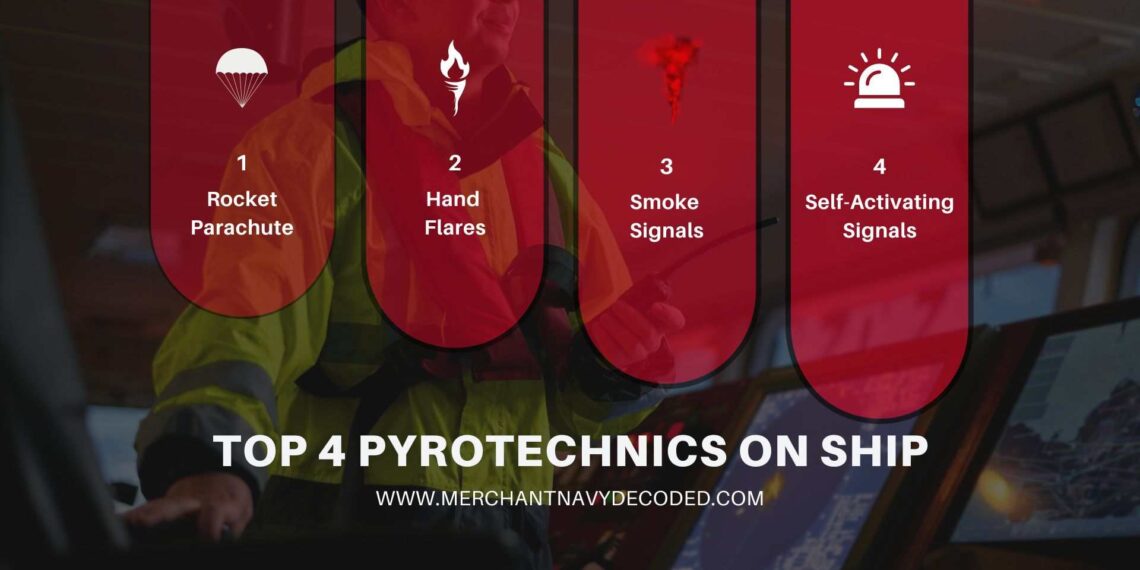Top 4 PyroTechnics Every Seafarer Must Know on Ship
1:- Overview
What is the most valued commodity onboard a ship? It’s You! Safety of Life is of utmost importance out at sea. The International Maritime Organization(IMO), is the principal governing body regulating safety components for the Marine Industry.
Pyrotechnics are such safety measures. They have proven to be life-saving in several situations and thus it becomes essential for seafarers to have an idea about them.
2:- What are Pyrotechnics on Ship?
- A part of several Life-saving appliances, pyrotechnic devices are tools that use a mixture of solid fuel and an oxidant, capable of self-sustaining combustion to produce one or multiple of the following: Heat, Light, Smoke, and Sound.
- Their design makes them generally compact and easy to use for emergency signaling.
- Under Chapter III of SOLAS, the LSA Code points out key features and requirements that ships must follow.
- The primary function of these devices is visual distress signals in an emergency and SOS.
3:- How do Pyrotechnics work?

- The basic principle behind the working of Pyrotechnics is similar to firecrackers that we generally use. There is an ignition source that ignites a chemical reaction, which in turn generates different forms of energy.
- They typically consist of a combination of oxidizers, fuel, and colorants that include substances like Potassium Nitrate, Sulphur, and various metals (for color).
- Igniting the fuse or electrical ignitor generates a self-contained and self-sustained chemical reaction.
- The design of the signal is such that it can sustain the chemical reaction to offer a desired effect, such as emitting smoke, for a specific duration
4:- Types of Pyrotechnics on Ships:
The safety officer must establish a safety management system, ensure proper familiarization, and confirm that the ship’s crew understands the instructions.
4.1:- Rocket Parachute Flares:

- It is a long-range distress signal
- As the name suggests, it launches a flare using a rocket when the casing is activated.
- The rocket propels it to a high altitude and upon reaching a maximum height, the parachute opens up.
- The flare burns with a bright red light for about 30-40 seconds in the air. High-quality flares continue to burn even in water for some time.
- You can see them from a distance of 10-40 miles.
4.2:- Hand Flares:

- These are Hand-held emergency signaling devices. They are essentially close-range devices
- They typically emit a bright red Light but may also emit smoke.
- They burn for a shorter duration, typically about 1-2 minutes.
- You can see them from a distance of 5-10 miles.
4.3:- Buoyant Smoke Signals:

- It is a day-light signal Flare
- This smoke signal emits a dense orange smoke visible from several kilometers away.
- You can activate it manually by pulling an internal loop.
You need to throw the signal into the water, and due to its buoyant nature, it floats and immediately emits smoke. - They emit smoke for about 3 minutes and can be seen from a range of 2-5 miles
4.4:- Self-Activating Smoke Signals:

- They are typically used with a life buoy and are called a MOB Marker.
- It emits orange-colored smoke for day-signaling and emits light for the night.
- Dropping the lifebuoy into the water activates the mechanism through the saltwater, making manual activation unnecessary.
- In man-overboard situations, you use them to mark the location as soon as the MOB is sighted or reported.
- It emits smoke for 15 minutes which is enough to initiate a Williamson Turn.
5:- Where are Pyrotechnics Kept on Ship:
- Depending upon the location of the ship, the minimum requirement of Pyrotechnics is set forth by the International Convention on the Safety of Life at Sea (SOLAS).
- The number of each set of Pyrotechnic may vary depending on the length and tonnage of the ship.
- However, the minimum requirements for pyrotechnics onboard, in liferaft, lifeboats, and the Navigation bridge are given in the following table:
| Location | Minimum Requirements |
| Bridge | Six hand flares, Twelve rocket parachute flares, Two buoyant smoke signals (one on each side, port and starboard), At least one line-throwing appliance. |
| Lifeboat | Six hand flares, Four rocket parachute flares Two buoyant smoke signals. |
| Liferaft | SOLAS Pack A: Six hand flares, Four rocket parachute flares Two buoyant smoke signals. SOLAS Pack B: Three-hand flares, Two rocket parachute flares One buoyant smoke signal. |
SOLAS’A’ Pack – Minimum equipment carried in liferafts on passenger and other ships on international voyages.
SOLAS ‘B’ Pack- Minimum equipment carried in liferaft on passenger vessels engaged in short voyages
6:- Maintenance and Expiry of Pyrotechnics:
- Due to the critical nature of these essential safety tools, timely maintenance is of utmost importance.
- Maintenance of safety items and other essential Personal Protective Equipment is a part of the Safety Management system.
- The following points should be kept in mind during Maintenance of Pyrotechnics:
- You should brief all personnel on how to properly use the devices.
- You should conduct routine visual inspections to assess general wear and tear.
You need to carry out maintenance every 2-3 weeks. - Check expiry dates and dispose of any expired pyrotechnics. The expiration period is usually 3-4 Years.
- Store the devices in a cool, dry, and well-ventilated space.
- Make sure all labels and markings are clearly visible.
- You should keep pyrotechnics away from fuel sources and combustible materials.
- You should conduct regular safety drills that include the use of pyrotechnics.
- Competent Crew members should be aware of the exact location of Pyrotechnics.
7:- Conclusion:
Safety is of paramount interest out at sea and most reputed companies follow a good safety culture, providing all necessary PPE and having a Safety Management system onboard. However the final responsibility of understanding how these devices work and proper maintenance lies with the crew of the vessel.
Disclaimer :- The opinions expressed in this article belong solely to the author and may not necessarily reflect those of Merchant Navy Decoded. We cannot guarantee the accuracy of the information provided and disclaim any responsibility for it. Data and visuals used are sourced from publicly available information and may not be authenticated by any regulatory body. Reviews and comments appearing on our blogs represent the opinions of individuals and do not necessarily reflect the views of Merchant Navy Decoded. We are not responsible for any loss or damage resulting from reliance on these reviews or comments.
Reproduction, copying, sharing, or use of the article or images in any form is strictly prohibited without prior permission from both the author and Merchant Navy Decoded.


